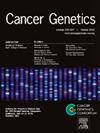POT1肿瘤易感综合征背景下多灶性骨肉瘤的戏剧性治疗反应
IF 2.1
4区 医学
Q4 GENETICS & HEREDITY
引用次数: 0
摘要
POT1肿瘤易感性(POT1- tpd)与一系列恶性肿瘤相关,这是由于POT1的功能突变丧失导致端粒延长和基因组不稳定。骨肉瘤是最常见的原发性骨恶性肿瘤,多灶性骨肉瘤预后较差。病例介绍:一名15岁的男性被发现患有原发性右股骨远端骨肉瘤,并伴有多处其他骨部位的疾病。在体细胞和种系中均鉴定出与POT1- tpd一致的POT1剪接位点变异(C .949+1G>;C)。尽管有广泛的多灶性,但肿瘤对标准护理治疗显示出明显的化疗敏感性,并实现了长期缓解。讨论:有证据表明,端粒功能的可遗传改变,包括POT1,在肉瘤易感性中富集。此外,遗传性肿瘤易感性综合征经常增加骨肉瘤的风险,包括最近报道的5例POT1-TPD患者。多灶性骨肉瘤是罕见的,但一些回顾性队列提示预后不佳。本报告详细介绍了一例假定为POT1-TPD的青少年男性,他发展为同步多灶性骨肉瘤,对化疗非常敏感,这可能代表了该综合征的独特表型。本文章由计算机程序翻译,如有差异,请以英文原文为准。
Dramatic multifocal osteosarcoma treatment response in the setting of POT1 tumor predisposition syndrome
INTRODUCTION: POT1 tumor predisposition (POT1-TPD) is associated with a spectrum of malignancies due to loss of function mutations in POT1 leading to telomere elongation and genomic instability. Osteosarcoma is the most common primary malignant bone tumor and has a poor prognosis when multifocal. CASE PRESENTATION: A 15-year-old male was found to have a primary right distal femur osteosarcoma with multiple additional bony sites of disease. A POT1 splice site variant (c.949+1G>C) was identified both somatically and in the germline consistent with POT1-TPD. Despite extensive multifocality, the tumor displayed marked chemosensitivity to standard of care therapy and long-term remission was achieved. DISCUSSION: Evidence suggests that hereditable alterations in telomeric function including POT1 are enriched in sarcoma susceptibility. Furthermore, hereditary tumor predisposition syndromes often increase osteosarcoma risk including a recent report of five patients with POT1-TPD. Multifocal osteosarcoma is rare, but a few retrospective cohorts suggest dismal prognosis. This report details an adolescent male with presumed POT1-TPD who developed synchronous multifocal osteosarcoma exquisitely sensitive to chemotherapy which may represent a unique phenotype for the syndrome.
求助全文
通过发布文献求助,成功后即可免费获取论文全文。
去求助
来源期刊

Cancer Genetics
ONCOLOGY-GENETICS & HEREDITY
CiteScore
3.20
自引率
5.30%
发文量
167
审稿时长
27 days
期刊介绍:
The aim of Cancer Genetics is to publish high quality scientific papers on the cellular, genetic and molecular aspects of cancer, including cancer predisposition and clinical diagnostic applications. Specific areas of interest include descriptions of new chromosomal, molecular or epigenetic alterations in benign and malignant diseases; novel laboratory approaches for identification and characterization of chromosomal rearrangements or genomic alterations in cancer cells; correlation of genetic changes with pathology and clinical presentation; and the molecular genetics of cancer predisposition. To reach a basic science and clinical multidisciplinary audience, we welcome original full-length articles, reviews, meeting summaries, brief reports, and letters to the editor.
 求助内容:
求助内容: 应助结果提醒方式:
应助结果提醒方式:


